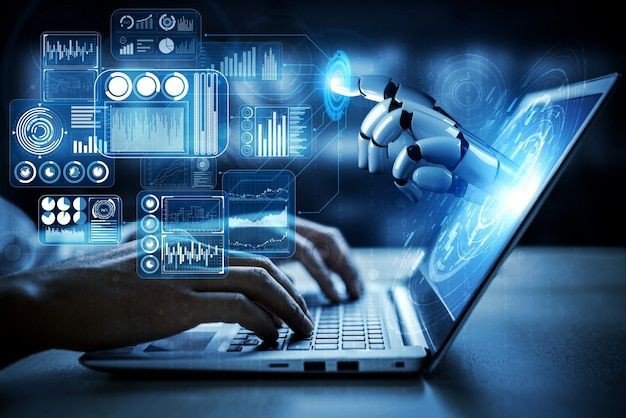
The rapid advancement of artificial intelligence (AI) and automation technologies is reshaping the future of work, raising important questions about how these innovations will impact jobs, industries, and the economy. While some fear that AI-driven automation will lead to widespread job displacement, others argue that AI can augment human capabilities, creating new opportunities and enhancing productivity. This article explores the complex dynamics between automation and augmentation, the potential impacts on the workforce, and the strategies that can help navigate the future of work.
Automation: The Replacement of Human Labor
Definition and Examples
Automation refers to the use of technology to perform tasks that were previously done by humans. This can range from simple mechanization, such as assembly line robots in manufacturing, to advanced AI systems capable of performing complex cognitive tasks, like customer service chatbots and financial trading algorithms.
Examples of automation include:
– Manufacturing Robots: Machines that can perform repetitive tasks, such as welding, painting, and assembly, with high precision and efficiency.
– Self-Checkout Kiosks: Automated systems in retail stores that allow customers to scan and pay for their purchases without cashier assistance.
– Automated Customer Support: AI-powered chatbots that handle customer inquiries, process orders, and provide technical support.
– Autonomous Vehicles: Self-driving cars and trucks that can navigate and operate without human intervention.
Impact on Employment
The impact of automation on employment has been a topic of significant debate. Automation can lead to job displacement, particularly in industries and roles that involve routine, repetitive tasks. For example, manufacturing and retail sectors have seen a decline in traditional jobs due to the adoption of robots and self-service technologies. Similarly, advancements in AI have automated tasks in areas like data entry, bookkeeping, and even journalism.
However, automation can also create new jobs and industries. As routine tasks are automated, demand for roles that require creativity, problem-solving, and interpersonal skills may increase. Additionally, the development, deployment, and maintenance of automation technologies create new employment opportunities in fields such as robotics, AI development, and cybersecurity.
Augmentation: Enhancing Human Capabilities
Definition and Examples
Augmentation refers to the use of technology to enhance human capabilities rather than replace them. AI and automation technologies can be used to support and empower workers, enabling them to perform tasks more efficiently and effectively. Augmentation can involve tools and systems that assist with decision-making, improve accuracy, and enhance productivity.
Examples of augmentation include:
– Decision Support Systems: AI-powered tools that analyze data and provide insights to help professionals make informed decisions. For example, doctors can use AI to analyze medical records and recommend treatment options.
– Collaborative Robots (Cobots): Robots designed to work alongside humans, assisting with tasks that require precision, strength, or repetitive actions. Cobots are commonly used in manufacturing and logistics.
– Intelligent Personal Assistants: AI-powered assistants like Siri, Alexa, and Google Assistant that help users manage tasks, set reminders, and access information.
– Augmented Reality (AR): AR technologies overlay digital information onto the physical world, providing real-time guidance and information. AR can be used in training, maintenance, and design.
Impact on Employment
Augmentation has the potential to enhance job satisfaction and productivity by allowing workers to focus on more meaningful and complex tasks. For example, in healthcare, AI can assist doctors with diagnostics, allowing them to spend more time on patient care. In manufacturing, cobots can handle physically demanding tasks, reducing the risk of injury and allowing workers to focus on quality control and problem-solving.
Augmentation also opens up opportunities for upskilling and reskilling. As technology changes the nature of work, workers can acquire new skills and adapt to new roles. For example, workers in traditional manufacturing roles may transition to roles in programming, robotics maintenance, or data analysis.
Balancing Automation and Augmentation
Economic and Social Considerations
The balance between automation and augmentation will have significant economic and social implications. While automation can lead to increased efficiency and cost savings for businesses, it can also result in job displacement and economic inequality. Conversely, augmentation can enhance human capabilities and create new opportunities, but it may require significant investment in training and education.
Policymakers and business leaders must consider how to manage the transition to a more automated and augmented workforce. This includes addressing potential job losses, ensuring fair access to new opportunities, and promoting inclusive growth. Key considerations include:
– Job Transition and Support: Providing support for workers displaced by automation, including unemployment benefits, retraining programs, and job placement services.
– Education and Training: Investing in education and training programs that equip workers with the skills needed for the future workforce, such as digital literacy, programming, and critical thinking.
– Inclusive Innovation: Ensuring that the benefits of AI and automation are widely shared, including promoting diversity and inclusion in the development and deployment of new technologies.
The Role of Organizations and Individuals
Organizations play a critical role in balancing automation and augmentation. By adopting a strategic approach to technology adoption, businesses can leverage the benefits of AI and automation while minimizing negative impacts on the workforce. This includes:
– Workforce Planning: Assessing the potential impact of automation on the workforce and developing strategies for reskilling and redeployment.
– Employee Engagement: Involving employees in the adoption of new technologies and providing opportunities for input and feedback.
– Ethical Considerations: Ensuring that the use of AI and automation aligns with ethical principles, including fairness, transparency, and accountability.
Individuals also have a role to play in navigating the future of work. As the nature of work changes, lifelong learning and adaptability will become increasingly important. Workers should be proactive in acquiring new skills and staying informed about technological trends. This may involve pursuing formal education, participating in online courses, or seeking out new experiences and challenges.
The Future of Work: Automation and Augmentation Coexistence
The future of work will likely involve a coexistence of automation and augmentation. While some tasks and roles may be fully automated, others will be augmented by AI and automation technologies. The key to a successful transition lies in leveraging the strengths of both automation and augmentation while addressing the challenges and risks.
Embracing Change and Innovation
As AI and automation technologies continue to evolve, businesses and workers must embrace change and innovation. This includes exploring new business models, adopting flexible work arrangements, and fostering a culture of continuous learning and improvement. By staying agile and adaptable, organizations and individuals can thrive in an increasingly automated and augmented world.
Ethical and Responsible AI
As AI becomes more integrated into the workplace, ethical considerations will become increasingly important. This includes ensuring that AI systems are transparent, fair, and accountable. Organizations must consider the potential social and ethical implications of AI, including issues related to privacy, bias, and job displacement. By adopting responsible AI practices, businesses can build trust and ensure that technology is used in a way that benefits society.
Collaborative Human-AI Partnerships
The future of work will likely involve collaborative human-AI partnerships, where humans and AI systems work together to achieve common goals. This collaboration can enhance creativity, problem-solving, and decision-making. For example, AI can provide data-driven insights, while humans can bring context, empathy, and ethical considerations to the decision-making process. By fostering effective human-AI collaboration, organizations can unlock new levels of innovation and productivity.
Conclusion
The rise of AI and automation is transforming the future of work, bringing both opportunities and challenges. While automation has the potential to displace certain jobs, it can also enhance efficiency and create new opportunities. Augmentation, on the other hand, can empower workers and enhance human capabilities. The key to navigating the future of work lies in finding the right balance between automation and augmentation.
Policymakers, business leaders, and individuals must work together to ensure that the benefits of AI and automation are widely shared and that the transition is managed in a way that promotes inclusive growth and social equity. By embracing change, investing in education and training, and fostering responsible AI practices, we can create a future of work that is innovative, inclusive, and sustainable.
ALSO READ: The Role of AI in Cybersecurity









